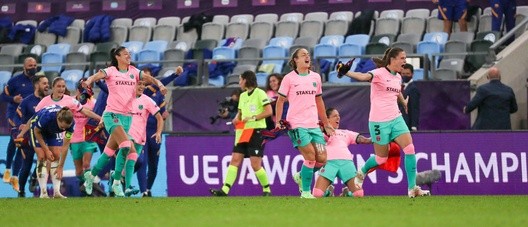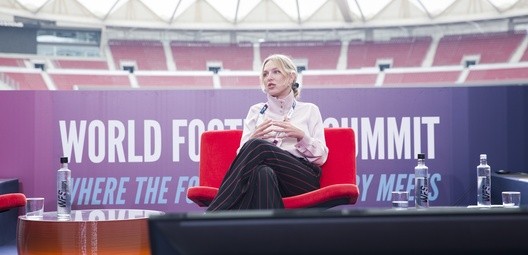Interview: DAZN betting big on Women’s Football and fighting hard to close “coverage gap”

Alamy
”We will continue to commercialize something that should have been done 10 years ago, to be honest,” says Arbesa Kastrati, DAZN vice-president strategy and implementation.
DAZN are changing their strategy around the Women’s Champions League season in 2022 – it will be shown for free on YouTube.
DAZN’s strategic approach in 2022 is different, but they are confident that their 10 years of experience from WTA - where they doubled the viewership – will see Women’s Football grow at great pace.
“The coverage gap”, a 30 per cent gap between the 93 per cent of sports fans who watch men's sports regularly and those that watch women's (63 per cent), can only be closed if the whole echo-system changes its habits.
6 December 2021 - 2:56 PM
With the precision and pace of a team that had consistently excelled and exhilarated to dominate both La Liga and the Champions League, Barcelona carved Chelsea open after just 33 seconds.
The 2021 final against the English champions, who’d always prove last on first and second balls, was the last stanza in Europe. The Spanish giants blew their opponents away, with three goals inside the first 21 minutes. They never looked back to win their first Champions League crown 4-0.
FC Barcelona became the first club to win both the women’s and men’s competition; Nigeria’s Asisat Oshoala the first African player to win the Champions League. In the modern era, Chelsea had been the first English club ever to reach the final.
There were many strands and narratives to this showcase event that unfortunately few could watch. The Barcelona - Chelsea final in Gothenburg was played behind closed doors due to Covid-19 restrictions by Swedish authorities.
BT Sport in the United Kingdom made the match free-to-air, but in Europe Barca TV and DAZN, a global streaming platform, required subscriptions to watch.
Reposition the competition
The 2022 season and final in Turin should be different. At the tail end of the pandemic perhaps, fans should be back in the stands and DAZN, UEFA’s official broadcast partner for the competition, will stream the competition for free on Youtube for the next two seasons, with the exception of the MENA region and China.

DAZN vice-president strategy and implementation Arbesa Kastrati, who joined the streaming giant from the Perform Group in 2016.
The idea behind the new strategy is simple: reposition the competition from a broadcast point of view to generate exposure and drive growth. In the past, the Women’s Champions League was not broadly accessible for the general public, but DAZN is now considering the tournament a top priority rather than just a mere CSR project.
“We’ve been investing in women's sports for ten years now,” explains DAZN vice-president strategy and implementation Arbesa Kastrati, who joined the streaming giant from the Perform Group in 2016.
“We've had the WTA for 10 years, we've doubled its viewership. So this isn't a new thing for DAZN, we always invested in it. What's new is, and what's groundbreaking is the type of deal that we've done, which is, you know, the first time ever, for any sport, you can see it all on one platform, globally. That's the first. Plus, it's all available for free.”
The Women’s Champions League is the crown-jewel-in-waiting in DAZN’s portfolio of women’s football broadcast rights that includes Germany’s Frauen Bundesliga, Italy’s Serie A Feminile, Japan’s WE League, France’s Division 1 Féminine and continental tournaments in Asia.
The streaming platform can draw on experience from those properties to maximize the potential of Europe’s premier club competition.
“With any type of sports, you know, don’t just slap it on the platform and expect there to just be viewership,” says Kastrati.
“You're always going to get that hardcore base that will come on regardless of what you do around it. But where you really get through to bigger audiences and mass-market is when you tell the story. It’s about covering it throughout.”
The DAZN vice-president, with a bachelor’s degree in mathematics, finance and economics from City University of London, points at “the coverage gap”, a 30 per cent gap between the 93 per cent of sports fans who watch men's sports regularly and those that watch women's (63 per cent), which was revealed by research her organization conducted in partnership with The Female Quotient in eight global markets.

Alamy | FC Barcelona celebrating Champions League win
In total, 64 per cent of consumers say they do not watch women's sports because they do not know enough about the athletes and teams, don't believe they have as many opportunities to watch women's sports or are not aware of where they can watch it.
The coverage gap is largely a broadcast gap, where minimal promotion of events, broadcast disparities and a lack of steady media and social coverage and storytelling creates a significant barrier to viewership.
“The key is storytelling,” says Kastrati. “More coverage leads to more eyes, more eyes leads to bigger and better things and more household names, which is this ripple effect that we're going to hone into.”
€24 million cash boost
From behind-the-scenes footage, club profiles to half-time shows, features so prevalent and ubiquitous in the men’s game, DAZN is ramping up coverage of the competition.

Japan’s Chairwoman of the New Pro Women’s Soccer League charts a course for success
3 May 2021 - 7:25 PM
This includes a ‘Game Of The Week’ and a special six-part, short-form series on various cities and their football scene. A number of match days have been scheduled to not conflict with the men’s game.
On matchday 1, Barcelona - Arsenal drew 346,000 viewers, on matchday 2, Juventus - Chelsea 237,000 viewers; which according to Kastrati were "viewership numbers exceeding expectations”. It’s about “impacting the full-ecosystem”.
That ecosystem has become more robust.
Last season, governing body UEFA decided to revamp the competition with a new brand identity, an enlarged calendar through the introduction of a proper group stage, centralized television rights and increased prize money.
UEFA announced a €24 million cash boost to teams across Europe and said that 23 per cent of the €24 million available via “solidarity payments” will go to women’s clubs not taking part in the tournament but whose leagues are represented in the competition. Each participating team is guaranteed an income of €400,000.

Alamy | British-Russian billionaire Leonard Blavatnik is the owner of DAZN
Since the launch of the new season, sportswear giant Adidas has come on board as a global sponsor of the tournament. A partnership between digital platform Ata Football, backed by 777 Partners, and DAZN has bolstered the competition’s distribution and presence in the United States.
Ata subscribers get access to 31 live matches, a way for DAZN to leverage Ata’s existing football community.
“It’s all been very organic,” says Kastrati. “We are certain that the demand is going to grow and we will continue to commercialize something that should have been done 10 years ago, to be honest.”
In 2023, midway through the four-year partnership with UEFA, DAZN’s faces a litmus test. It will shift away from the full free-to-air model to all matches shown on DAZN and 19 will be free on YouTube, but Kastrati doesn’t seem worried over the question of how current and future audiences will be consolidated to monetize the product.
Billions invested
DAZN needs the Women’s Champions League to be a success. Launched in 2016 and owned by British-Russian billionaire Leonard Blavatnik, DAZN has invested billions on sports rights with the aim of becoming “an indispensable part of sports fans lives”.
But even after the sale of Perform subsidiary to Vista Equity Partners for a reported $1 billion in 2019 and the introduction of cost-saving measures to address the financial fallout of the global health crisis, the model of offering exclusive live sports on a market-to-market basis at low prices has not quite worked.
At the end of 2019, DAZN, the company’s published set of accounts show, carried a staggering loss of $2.3 billion.
That won’t prevent Kastrati and DAZN from doing everything required to transform these broadcast rights into a “massive revenue driver”.
With all the ingredients - the investment, the football ecosystem and the consumers - to succeed present, they understand the value gold-encrusted value of a high-profile club competition.
DAZN, then, is betting big and bold.

